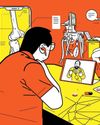
A giant ivory-coloured smiling baby with a stethoscope dangling from its ears sits in the middle of the lobby at Fortis Memorial Research Institute in Gurgaon near Delhi. The diaphragm of the stethoscope rests firmly on the ground. The sculpture had been commissioned by brothers Malvinder and Shivinder Mohan Singh, the founders of India’s second-largest hospital chain, Fortis Healthcare Ltd. The baby represents Fortis, and the stethoscope signifies its grounded approach to the business of health care. “We had asked artist Jitish Kallat to do a marquee piece for us for our ninth anniversary (in 2010),” says 40-year-old Shivinder, the younger of the two brothers and executive vice chairman of the company. “We [Fortis] have become very large but are child-like in our approach to health care because we still have our ear to the ground.”
Five years have gone by since the installation of the sculpture, during which time Fortis’s revenue has increased 341 percent from Rs 938 crore in FY2010 to Rs 4,140 crore in FY2015. Shivinder jokes that the baby, too, should have grown in size. “Maybe we need to give it some clothes and shoes,” he laughs. Almost immediately, the mirth fades and he adds solemnly: “But we did sell a lot of our international assets as well, so that reduced our size.” And this sums up Fortis Healthcare’s 14-year-old journey, which started in 2001 with a single hospital in Mohali, Punjab.
Denne historien er fra September 18, 2015 -utgaven av Forbes India.
Start din 7-dagers gratis prøveperiode på Magzter GOLD for å få tilgang til tusenvis av utvalgte premiumhistorier og 9000+ magasiner og aviser.
Allerede abonnent ? Logg på
Denne historien er fra September 18, 2015 -utgaven av Forbes India.
Start din 7-dagers gratis prøveperiode på Magzter GOLD for å få tilgang til tusenvis av utvalgte premiumhistorier og 9000+ magasiner og aviser.
Allerede abonnent? Logg på

Home-Cooked Meal Is Now Greatly Valued
The pandemic has also brought with it an improved focus on hygiene, use of technology in dining, rise of cloud kitchens and resurgence in popularity of Indian ingredients

Paytm 3.0 - Reaching Near Breakeven In Two Years
As of 2020, Vijay Shekhar Sharma’s super app for financial services had run up losses in thousands of crores. Now, as digital payments gets yet another boost courtesy Covid-19, he’s hopeful of reaching near breakeven in two years

THE PANDEMIC HAS CAUSED WOMEN GREATER LABOUR PAIN
Covid-19 has shown that women are more likely to face the brunt of job losses than men, and find fewer opportunities when they want to resume. That apart, several have to deal with increased hours of unpaid work at home and even domestic abuse

LEADERSHIP WILL BE ABOUT SEEING THE BIGGER PICTURE
Leaders must not only guard their teams first during a crisis, but also deal with stakeholders with respect and dignity. And apart from pursuing business goals, they should remain committed to our planet and the environment

PHILANTHROPY SHOULD BE HUMBLE, BUT NOT MODEST
Apart from building a flexible and resilient framework for the future, philanthropists, civil society and the government must work in tandem so that every rupee is absorbed on the ground

INTEGRATED HEALTH CARE, TECH WILL DISRUPT SECTOR
While clinical research will get a boost, having a skilled workforce and public spending on health care will be challenges in the near term

DIGITALISATION WILL HELP IN VALUE CREATION
As the pandemic brings technology and innovation to the core of business and daily life, the next decade will see about 150 million digital-first families in India

Industry 4.0: Climate Revolution?
Augmenting sustainability alongside digital capabilities is an economic, competitive and global opportunity for India’s businesses, but regulations need to reflect intent

EV Dream Still Miles Away
Electric vehicles have remained a buzzword in India for years. But not much has moved on ground due to high upfront costs, range anxiety and charging infrastructure

Living Waters
A virus has caused us to scramble for oxygen but our chokehold on the environment is slowly strangling the very waters that breathe life into us. The virus is a timely reminder: We are merely consumers, not producers of life’s breath on this planet